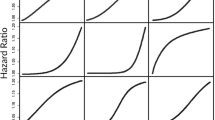Abstract
Environmental justice reflects the equitable distribution of the burden of environmental hazards across various sociodemographic groups. The issue is important in environmental regulation, siting of hazardous waste repositories and prioritizing remediation of existing sources of exposure. We propose a statistical framework for assessing environmental justice. The framework includes a quantitative assessment of environmental equity based on the cumulative distribution of exposure within population subgroups linked to disease incidence through a dose-response function. This approach avoids arbitrary binary classifications of individuals solely as 'exposed' or 'unexposed'. We present a Bayesian inferential approach, implemented using Markov chain Monte Carlo methods, that accounts for uncertainty in both exposure and response. We illustrate our method using data on leukaemia deaths and exposure to toxic chemical releases in Allegheny County, Pennsylvania.
Similar content being viewed by others
References
Anderton, D.L., Anderson, A.B., Oakes, J.M. and Fraser, M.R. (1994) Environmental equity: the demographics of dumping. Demography, 31, 229-48.
Bernardinelli, L., Pascutto, C., Best, N.G. and Gilks, W.R. (1997) Disease mapping with errors in covariates. Statistics in Medicine, 16, 741-52.
Besag, J., York, J.C. and MollieÂ, A. (1991) Bayesian image restoration, with two applications in spatial statistics (with discussion). Annals of the Institute of Statistical Mathematics, 43, 1-59.
Bowen, W.M., Salling, M.J., Haynes, K.E. and Cyran, E.J. (1995)Toward environmental justice: Spatial equity in Ohio and Cleveland. Annals of the Association of American Geographers, 85, 641-63.
Carlin, B.P. and Louis, T.A. (1996) Bayes and Empirical Bayes Methods for Data Analysis. Chapman and Hall, London.
Clayton, D.G. and Bernardinelli, L. (1992) Bayesian methods for mapping disease risk. In Geographical and Environmental Epidemiology: Methods for Small-Area Studies, P. Elliott, J. Cuzick, D. English, and R. Stern (eds). Oxford University Press, London.
Cox, L.H. and Piegorsch, W.W. (1996) Combining environmental information I: Environmental monitoring, measurement and assessment. Environmetrics, 7, 299-308.
Cutter, S.L., Holm, D. and Clark, L. (1996) The role of geographic scale in monitoring environmental justice. Risk Analysis, 16, 517-26.
Cutter, S.L., and Solecki, W.D. (1996) Setting environmental justice in space and place: acute and chronic airborne toxic releases in the southeastern United States. Urban Geography, 17, 380-99.
Escobar, M.D. and West, M. (1995) Bayesian density estimation and inference using mixtures. Journal of the American Statistical Association, 90, 577-88
Flowerdew, R. and Green, M. (1992) Developments in areal interpolation methods and GIS. Annals of Regional Science, 26, 67-78.
Gastwirth, J.L., Nayak, T.K. and Wang, J.-L. (1989) Statistical properties of measures of between-group income differentials. Journal of Econometrics, 42, 5-19.
Gelman, A., Roberts, G.O. and Gilks, W.R. (1996) Efficient Metropolis jumping rules. In Bayesian Statistics 5, J.M. Bernardo, J.O. Berger, A.P. Dawid, and A.F.M. Smith (eds). Oxford University Press, Oxford, pp. 599-607.
Glickman, T.S. and Hersh, R. (1995) Evaluating environmental equity: the impacts of industrial hazards on selected social groups in Allegheny County, Pennsylvania. Discussion paper 95-13. Resources for the Future, Washington DC.
Hastings, W.K. (1970) Monte Carlo sampling methods using Markov chains and their applications. Biometrika, 57, 97-109.
Hodge, D. and Gatrell, A. (1976) Spatial constraint and the location of urban public facilities. Environment and Planning A, 8, 215-30.
Kohn, R.E. (1975) Air Pollution Control: A Welfare Economic Interpretation. D.C. Heath, Lexington, MA.
McLafferty, S. (1984) Constraints on distributional equity in the location of public services. Political Geography Quarterly, 3, 33-47.
McLafferty, S.L. and Ghosh, A. (1982) Issues in measuring differential access to public services. Urban Studies, 19, 383-9.
Mugglin, A. and Carlin, B.P. (1997) Hierarchical modeling in geographic information systems: Population interpolation over incompatible zones. Research Report 97-004, Division of Biostatistics, University of Minnesota.
Myers, D.E. (1993) Spatial statistics. In Environmental Modeling with GIS, M.F. Goodchild, B.O. Parks, and L.T. Steyaert (eds). Oxford University Press, New York.
Nayak, T.K. and Gastwirth, J.L. (1989) The use of diversity analysis to assess the relative influence of factors affecting the income distribution. Journal of Business and Economic Statistics, 7, 453-60.
O'Connell, J.F. (1982) Welfare Economic Theory. Auburn House, Boston.
Piegorsch, W.W. and Cox, L.H. (1996) Combining environmental information II: Environmental epidemiology and toxicology. Environmetrics, 7, 309-24.
Roemer, J.E. (1996) Theories of Distributive Justice. Harvard University Press, Cambridge, MA.
Sacks, J. and Steinberg, L.J. (1994) Environmental equity: statistical issues, report of a forum. National Institute of Statistical Sciences Technical Report No. 11.
Schwarz, G. (1978) Estimating the dimension of a model. Annals of Statistics, 6, 461-4.
Sexton, K. Olden, K. and Johnson, B.L. (1993) 'Environmental justice': the central role of research in establishing a credible scientific foundation for informed decision making. Toxicology and Industrial Health, 9, 685-727.
Wagener, D.K. and Williams, D.R. (1993) Equity in environmental health: data collection and interpretation issues. Toxicology and Industrial Health, 9, 775-95.
Waller, L.A., Carlin, B.P., Xia, H. and Gelfand, A. (1997) Hierarchical spatio-temporal mapping of disease rates. Journal of the American Statistical Association. To appear.
Zimmerman, R. (1993) Social equity and environmental risk. Risk Analysis, 13, 649-66.
Author information
Authors and Affiliations
Rights and permissions
About this article
Cite this article
Waller, L.A., Louis, T.A. & Carlin, B.P. Bayes methods for combining disease and exposure data in assessing environmental justice. Environmental and Ecological Statistics 4, 267–281 (1997). https://doi.org/10.1023/A:1018586715034
Issue Date:
DOI: https://doi.org/10.1023/A:1018586715034




